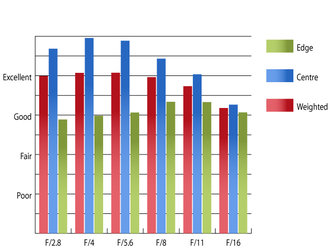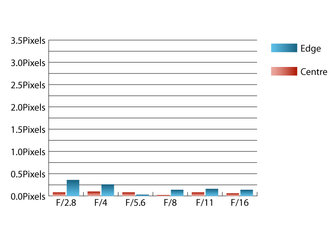Fujifilm Fujinon XF 27mm f/2.8 Lens Review
Fujifilm Fujinon XF 27mm f/2.8 Performance
At maximum aperture, sharpness in the centre of the frame is already outstanding. Unfortunately the clarity recorded towards the edges of the frame isn't quite as impressive, falling just short of good sharpness levels at maximum aperture. Stopping down does little to improve sharpness across the frame with high levels of sharpness being retained in the centre and clarity towards the edges of the frame lagging behind somewhat all the way down to f/11.  Resolution @ 27mm | How to read our chartsThe blue column represents readings from the centre of the picture frame at the various apertures and the green is from the edges. Averaging them out gives the red weighted column.The scale on the left side is an indication of actual image resolution. The taller the column, the better the lens performance. Simple. For this review, the lens was tested on a Fujifilm X-Pro1 using Imatest. |
Chromatic aberrations are incredibly well controlled with fringing only just exceeding a quarter of a pixel width towards the edges of the frame at f/2.8. This low level of fringing will be very hard to spot in images, even in areas of high contrast towards the edges of the frame.
 Chromatic aberration @ 27mm | How to read our chartsChromatic aberration is the lens' inability to focus on the sensor or film all colours of visible light at the same point. Severe chromatic aberration gives a noticeable fringing or a halo effect around sharp edges within the picture. It can be cured in software.Apochromatic lenses have special lens elements (aspheric, extra-low dispersion etc) to minimize the problem, hence they usually cost more. For this review, the lens was tested on a Fujifilm X-Pro1 using Imatest. |
Falloff of illumination towards the corners of the frame is reasonably well controlled. At maximum aperture the corners are 1.7 stops darker than the image centre. Visually uniform illumination is achieved with the aperture stopped down to f/5.6 or beyond.
Just over 0.8% barrel distortion is present, which may seem a little high for a prime lens. Even so, this low level of distortion shouldn't pose too many issues for general photography. If absolutely straight lines are paramount, you'll be glad to know that the distortion pattern is uniform across the frame, which should make applying corrections in image editing software relatively straightforward.
Flare can sometimes be an issue with this lens and contrast suffers noticeably when shooting into the light. Extra care may need to be taken when using this lens in harsh lighting conditions as a result.
Add your message
Login required
Please login here or if you've not registered, you can register here. Registering is safe, quick and free.
Please login here or if you've not registered, you can register here. Registering is safe, quick and free.
photodo Stats
1102 lenses
428 MTF tests
74 in-depth photodo reviews
100+ users join each day
Help the lens community by reviewing or rating a lens today via our lens search
428 MTF tests
74 in-depth photodo reviews
100+ users join each day
Help the lens community by reviewing or rating a lens today via our lens search
Latest Lens Reviews
- Chinon 28mm f/2.8 Vintage Lens Review
- Canon EF 70-200mm f/4L IS II USM Lens Review
- Samyang AF 85mm f/1.4 EF Review
- Sigma 70mm f/2.8 DG Macro Art Review
- Samyang AF 24mm f/2.8 FE Review
- Meike 50mm f/1.7 Review
- Tamron 70-210mm f/4 Di VC USD Review
- Lensbaby Burnside 35mm f/2.8 Review
- Asahi Super Takumar 50mm f/1.4 Review
- Asahi Super-Multi-Coated Takumar 135mm f/3.5 Review
